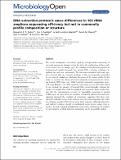DNA extraction protocols cause differences in 16S rRNA amplicon sequencing efficiency but not in community profile composition or structure

View/
Author
Rubin, Benjamin E R
Hampton-Marcell, Jarrad
Owens, Sarah M
Gilbert, Jack A
Moreau, Corrie S
Published Version
https://doi.org/10.1002/mbo3.216Metadata
Show full item recordCitation
Rubin, Benjamin E R, Jon G Sanders, Jarrad Hampton-Marcell, Sarah M Owens, Jack A Gilbert, and Corrie S Moreau. 2014. “DNA extraction protocols cause differences in 16S rRNA amplicon sequencing efficiency but not in community profile composition or structure.” MicrobiologyOpen 3 (6): 910-921. doi:10.1002/mbo3.216. http://dx.doi.org/10.1002/mbo3.216.Abstract
The recent development of methods applying next-generation sequencing to microbial community characterization has led to the proliferation of these studies in a wide variety of sample types. Yet, variation in the physical properties of environmental samples demands that optimal DNA extraction techniques be explored for each new environment. The microbiota associated with many species of insects offer an extraction challenge as they are frequently surrounded by an armored exoskeleton, inhibiting disruption of the tissues within. In this study, we examine the efficacy of several commonly used protocols for extracting bacterial DNA from ants. While bacterial community composition recovered using Illumina 16S rRNA amplicon sequencing was not detectably biased by any method, the quantity of bacterial DNA varied drastically, reducing the number of samples that could be amplified and sequenced. These results indicate that the concentration necessary for dependable sequencing is around 10,000 copies of target DNA per microliter. Exoskeletal pulverization and tissue digestion increased the reliability of extractions, suggesting that these steps should be included in any study of insect-associated microorganisms that relies on obtaining microbial DNA from intact body segments. Although laboratory and analysis techniques should be standardized across diverse sample types as much as possible, minimal modifications such as these will increase the number of environments in which bacterial communities can be successfully studied.Other Sources
http://www.ncbi.nlm.nih.gov/pmc/articles/PMC4263514/pdf/Terms of Use
This article is made available under the terms and conditions applicable to Other Posted Material, as set forth at http://nrs.harvard.edu/urn-3:HUL.InstRepos:dash.current.terms-of-use#LAACitable link to this page
http://nrs.harvard.edu/urn-3:HUL.InstRepos:13581115
Collections
- FAS Scholarly Articles [18292]
Contact administrator regarding this item (to report mistakes or request changes)


